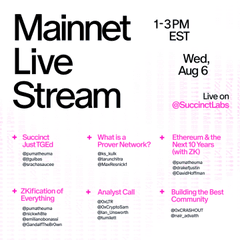'Proof of Consensus': How SuccinctLabs builds a unified trust language for a multi-chain universe
Beyond asset cross-chain: How Succinct unifies the entire Web3 world through 'Proof of Consensus'
We usually think of cross-chain bridges as a means to transfer assets, but this is just the tip of the iceberg. A truly interconnected Web3 future requires chains to be able to safely and trustlessly 'communicate' and 'understand' each other's states. SuccinctLabs, through its ZK light client technology, is building a universal trust language—'Proof of Consensus'—whose potential far exceeds simple asset transfer.
The core idea of 'Proof of Consensus' is to use ZK-SNARKs to generate a concise proof of a chain's consensus state (for example, the latest block header) that can be efficiently verified by a smart contract on another chain. It's like establishing an absolutely reliable communication channel between two independent 'nations' (blockchains) guaranteed by mathematics, rather than diplomats (validators).
The unlocking of this capability will give rise to countless brand new application scenarios:
Cross-chain governance: A DAO on the Ethereum mainnet can confirm the voting results on an L2 chain by validating the 'Proof of Consensus' of that L2 and automatically executing the corresponding governance actions. Multi-chain DeFi protocols: A derivatives protocol built on a high-performance chain can trustlessly read and use price oracle data from the Ethereum mainnet, as it can directly validate Ethereum's consensus state. Unified liquidity layer: Cross-chain lending protocols can securely distribute users' assets across multiple chains, as they can verify the collateral status on each chain through 'Proof of Consensus.'
What SuccinctLabs is doing is merging the entire multi-chain world from a series of information islands into a single, state-interoperable, trustful 'super state machine.'
From 'cryptographic problem' to 'engineering problem': How Succinct empowers developers
The 'iPhone moment' of ZK development: How Succinct enables every developer to harness the power of ZK
Zero-knowledge proof (ZK) technology is undoubtedly the future of blockchain, but for a long time, it has felt more like an 'ivory tower' belonging to cryptography PhDs and top researchers, with an extremely complex development process and a daunting barrier to entry. What SuccinctLabs is doing is leading the 'iPhone moment' of ZK development—transforming this powerful technology from a complex 'cryptographic problem' into a 'software engineering problem' that developers can easily tackle.
In the past, a developer wanting to leverage ZK would have to learn complex mathematical theories from scratch and handwrite intricate constraint circuits. However, Succinct has abstracted all of this through its standardized protocols and advanced software development kits (SDKs). Now, an average Web3 developer can easily integrate ZK as if calling a standard software library, without needing to understand the details of polynomial commitments or elliptic curves.

ZK functionality integrated into its own applications.
Developers can now focus on 'What to prove' rather than 'How to prove.' They can think about application logic issues, such as: 'How do I prove a transaction is private?' or 'How do I prove that an AI model's computation is correct?' and then use the tools provided by Succinct to achieve this. This revolutionary enhancement of the development experience is liberating the power of ZK from a handful of elites to thousands of Web3 builders. This will greatly accelerate the explosion of ZK-native applications, just as the emergence of the iPhone spurred the explosive growth of the mobile application ecosystem.



